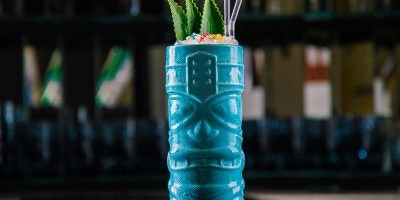We’re now only a decade into the rise of the craft distillery movement. And yet it’s hard to remember a time when American whiskeys made with complex grain recipes, barrel finishes, and unusual woods weren’t behind every bar. A surprising number of these experiments came from the mind of a single man. May we introduce you to Chris Morris, Master Distiller of the Woodford Reserve Distillery.
Whiskey Innovation History
Home to one of the top selling bourbons in its category, the Woodford Reserve Distillery also houses a line of experimental whiskeys dubbed “The Master’s Collection.” This set of spirits springs from the Woodford Reserve Charter – a private document created by Morris and former Brown-Forman Chairman & CEO Owsley Brown II. This company strategic document declares the distillery to be “a home of whiskey innovation.”
Like most historic distilleries in Kentucky, the current Woodford Reserve Distillery site has had a succession of owners and distillers over its 200+ year history. Chief among them were Oscar Pepper and Dr. James Christopher Crow, two legendary figures in bourbon’s history. “The Master’s Collection is also a nod to trying to articulate the history of this site, which was the site of whiskey innovation under Pepper and Crow,” Morris explains. “So let’s honor them with innovation, continuing innovation.”
Beginning the Innovations
Grains are the first of what Morris describes as the ‘Five Sources of Flavor’. Water, fermentation, distillation and maturation round out the set. Morris won’t change the water, and so far has altered fermentation once (Sweet Mash Bourbon). This leaves grains and maturation as the primary experimental variables.
The first of Morris’s experiments released under The Master’s Collection name was a Four-Grain Bourbon. He started with the standard Woodford Reserve grain bill of corn, rye and malted barley, and to that added wheat. Today, craft distilleries routinely combine both wheat and rye or experiment with exotic grains. But at the time – the releases were in 2005 and 2006 – Morris’s Four Grain was the first. (Of the modern era, anyway; we have scant record of what the little farmer-distillers of yore were doing.)
Photo Credit: Woodford Reserve / Chris Morris & Master Taster Elizabeth O’Neill
Finishing Touches
Changing maturation usually involves a ‘finishing’ maturation – taking fully mature spirit from its original barrel and placing it into a second one for additional resting in the rickhouse.
About half of the Master’s Collection releases to date have been finished bourbons. The first – coinciding with a similar product from Buffalo Trace – was a wine-finished bourbon which used Sonoma-Cutrer Chardonnay barrels. Paired with the Buffalo Trace product, these two spirits marked the first time bourbon utilized non-distilled or fortified wine barrels.
The next three finishes are whiskeys that have seen no equivalent. First, in 2009, Morris released Seasoned Oak Finish, a bourbon finished in barrels made from oak which had seasoned for a staggering five years. (Most oak is seasoned less than a year.) The result was an exceptionally dark, woody and spicy bourbon with little bitterness or harshness. Next, in 2010 we saw the Maple Wood Finish with barrels made from the aforementioned wood. It’s the first and (to date) only time maple wood barrels served this purpose. Since then other whiskeys have used maple wood pieces in aging with a process known as ‘chipping,’ or have used oak barrels that previously held maple syrup to finish the aging process. Then, in 2011, Morris used not one but three different finishing barrels – new maple wood, ex-sherry and ex-port – to create Four Wood.
Experiments for Everybody
While the Master’s Collection Bourbons are limited releases, the research behind them creates new whiskeys with full distribution. “The Master’s Collection was always intended to be an incubator for possible future brands, expressions,” Morris explains. “The Master’s Collection was never to be repeated – that was an agreement that I personally had with Owsley Brown II – but that didn’t mean we couldn’t alter it, adapt it for a full line extension. Double Oaked is an example of that – Double Oaked comes out of the Seasoned Oak Finish work.”
Double Oaked is an impressive whiskey is its own right. It has the distinction of being the first bourbon finished in a new barrel to be offered in permanent release. Additionally, it is the first bourbon finished in a heavily-toasted new barrel. The other current line extension is Woodford Reserve Rye – spun off from the Rare Rye Selection of 2011.
Photo Credit: Woodford Reserve / Chris Morris
Support Structures
To manage his hundreds of experiments – many of which stretch across years – Morris has an enormous support system available to him. Within the Research & Development lab at Brown-Forman’s corporate headquarters in Louisville, KY, Morris has an entire second distillery – a one-tenth scale replica of the Woodford Reserve Distillery. At that size, it’s similar in capability to many of the 1,500 craft distilleries now opening across the U.S. And yet it doesn’t produce a single drop of spirit intended for release. Everything done in the mini-Woodford distillery goes for R&D.
The lab also comes with a large team who perform the experiments Morris requests. He doesn’t visit the lab every day, but when he does, he has a docket-full of experiments to review. Also in Louisville, Brown-Forman has its own cooperage where Morris’s experimental barrels are built and finishing barrels are sourced. The used barrel market is tight and finishing barrels are often hard for smaller distilleries to acquire.
“[We] use our cooperage to obtain [used] barrels from wineries and port suppliers and sherries suppliers and Cognac suppliers because they need our used barrels for their business and therefore we have a relationship and trade leverage,” Morris explains.
Innovating Beyond Bourbon
Morris’s commitment to flavor and communicating it extends to the culinary arts, as well. The Woodford Reserve Distillery is the only bourbon distillery with a permanent chef-in-residence, the five-times James Beard-nominated Ouita Michel. Releases of new whiskeys accompany multi-course meals custom-designed to showcase the whiskey’s flavor profile. Craft cocktails often make an appearance as well.
With chef-crafted whiskey dinners and the word ‘experimental’ now part of the daily whiskey scene, one wonders how Morris views the changes. “It’s a great compliment,” he says. “The innovation that we have done here is a way to start carving out different concepts … we cannot own – nobody can own – this vast array of potential or possibilities.”
Thirsty for some bourbon?
With Distiller, you’ll always know what’s in the bottle before you spend a cent. Rate, Review, and Discover spirits! Head on over to Distiller, or download the app for iOS and Android today!



